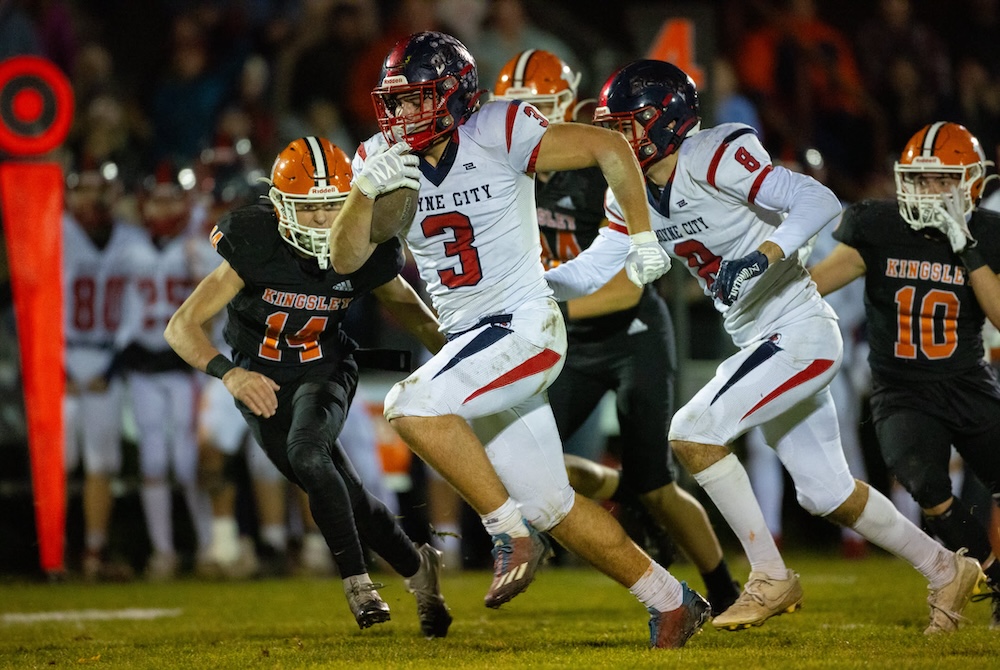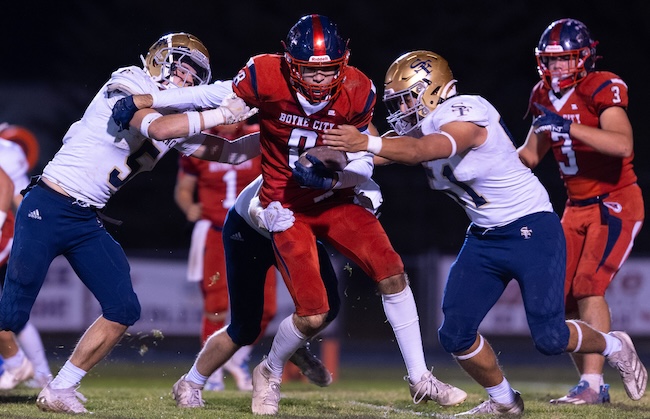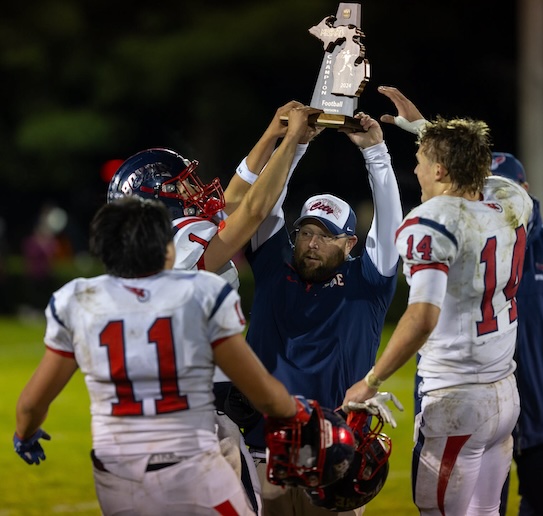
Casting Lines for Future Tournaments
August 12, 2016
By Jack Roberts
MHSAA Executive Director
The MHSAA is best known to the public for the tournaments it conducts to conclude the fall, winter and spring seasons each school year.
These tournaments, the first and largest program of the MHSAA, have survived the Vietnam War, the Korean conflict and two World Wars. They have survived the technology bubble, the housing collapse, the energy crisis and the Great Depression.
MHSAA tournaments existed at the dawn of aviation and at the time of our nation’s lunar landing. Popes, presidents and governors have changed and changed again and again, and MHSAA tournaments roll on year after year.
But the sense of tradition and permanence and inevitability of MHSAA tournaments doesn’t dissuade us from asking questions about our tournaments, even some of the most basic questions. Here are two.
Question #1
I have long been and will always be an advocate for a Ryder Cup format for the MHSAA Golf Finals, and a team tennis approach to the MHSAA Tennis Finals; but 90 years of tradition is hard to overcome. Might this be a more exciting format? Could it be co-ed? Could it reverse the decline in boys tennis participation, and increase girls golf participation? Wouldn’t it be fun to try?
Periodically, the International Olympic Committee requires each of the designated Olympic sports to defend its status, to state its case why the sport should remain a part of the Olympic program. Then, after a series or votes that retain one sport at a time, the IOC drops the sport that makes the weakest case. It does so to make room for one of the previously unlisted sports that makes the best case for inclusion.
This would appear to keep the existing Olympic sports on their toes, and to keep the Olympic movement fresh and reflective of modern trends in sports.
While I would not enjoy the controversy, I can see the potential for some positive results if the MHSAA were to invoke the same policy for determining the 14 tournaments it will provide for girls and the 14 for boys.
This might cause us to consider more deeply what a high school sport should look like, or at least what an MHSAA tournament sport should stand for.
On the one hand, we might be inclined to drop tournaments for those sports that involve mostly non-faculty coaches and non-school venues, or require cooperative programs to generate enough participants to support a team, or resort almost entirely to non-school funding, or cater to individuals more than teams.
Or perhaps this process would cause policymakers to forget traditional thinking and ask: “In this day and age, should we shake off traditional notions of sport and consider more where modern kids are coming from?” That might mean fewer team sports and more individual sports, more “extreme” sports like snowboarding and skateboarding, and more lifetime sports, meaning not just golf and tennis and running sports, but also fishing and even shooting sports.
Currently, MHSAA policy states that the MHSAA will consider sponsorship of a tournament series for any sport which 64 member schools conduct on an interscholastic basis as a result of action by the governing boards of those schools.
Should the only question be how many schools sponsor a sport, or must an activity also have certain qualities and/or avoid certain “defects?” What should an MHSAA tournament sport look like and stand for?
Question #2
Bristling from criticism that his association is a money-grabbing exploiter of children, my counterpart in another state said, “If we were running our programs just to make money, we would do very many things very differently.” I knew exactly what he meant.
Because we care about the health and welfare of students, because we mean what we say that the athletic program needs to maximize the ways it enhances the school experience while minimizing academic conflicts, and because we try to model our claim that no sport is a minor sport when it comes to its potential to teach young people life lessons, we operate our programs in ways that make promoters, marketers and business entrepreneurs laugh, cry or cringe.
If money were the only object, we would seed and select sites to assure the teams that attracted the most spectators had the best chance to advance in our tournaments, regardless of the travel for any team or its fan base. If money were the only object, we would never schedule two tournaments to overlap and compete for public attention, much less tolerate three or four overlapping events. If money were the only object, we would allow signage like NASCAR events and promotions like minor league baseball games.
Those approaches to event sponsorship may not be all wrong; they’re just not all right for us. And we will live with the consequences of our belief system.
During a typical school year, more than 20 percent of the MHSAA’s 2,097 District, Regional and Final tournaments lose money. Not a single site in golf, skiing or tennis makes a single penny. In no sport did every District, Regional and Final site have revenue in excess of direct expenses.
In fact, in only three sports – boys and girls basketball and football – is revenue so much greater than direct expenses overall that it helps to pay for all the other tournaments in which the MHSAA invests.
That’s right: invests. When we present our budget to our board, we talk about the MHSAA’s investment in providing tournament opportunities in all those sports and all those places that cannot sustain the cost of those events on their own. How much is this investment worth to students, schools and society?
These two are core questions that require our focus far in advance of talk about scheduling, site selection, seeding and the myriad matters that too often hijack our time and attention.

Surge Becoming Storied as Boyne City Continues Memorable Playoff March
By
Tom Spencer
Special for MHSAA.com
November 22, 2024
Not many would say Boyne City’s football team followed the script this season.
 After the way the Ramblers started this fall, only a scriptwriter could have envisioned the season they’ve enjoyed.
After the way the Ramblers started this fall, only a scriptwriter could have envisioned the season they’ve enjoyed.
Boyne City started with just 17 varsity players in August. After moving up some from the JV squad and losing their opener to Standish-Sterling 33-14, the Ramblers picked up a couple of wins. They then fell in Week 4 to Kingsley, last year’s Division 6 champion, 26-20.
But that’s where the losses stopped. Boyne City is on an eight-game winning streak – which included a 21-15 victory over Kingsley in the District Final two weeks ago.
And when the Ramblers found themselves down 14-0 to Reed City midway through the second quarter last week in their Division 6 Regional Final, nobody would have blamed them for abandoning the script.
But if there is one, it called junior Owen Hewitt’s number. He took over, scoring four touchdowns to lead Boyne to a 35-28 win that advanced the Ramblers to Saturday’s Semifinal against Lansing Catholic.
 “It wasn’t a dire situation,” said Boyne City coach Dave Suttle. “Our quarterback Drew Neer all year long has run our offense very well, and when we need a big play he’s always there. We threw a little curl, dig route over the middle to Owen and he went 63 yards for the score and kind of rejuvenated our team.”
“It wasn’t a dire situation,” said Boyne City coach Dave Suttle. “Our quarterback Drew Neer all year long has run our offense very well, and when we need a big play he’s always there. We threw a little curl, dig route over the middle to Owen and he went 63 yards for the score and kind of rejuvenated our team.”
Neer, also a junior, has connected with Hewitt and senior Jaden Alger the most this season. Hewitt’s first TD came with 1:22 left in the first half. Hewitt’s second was Boyne’s first offensive play of the second half and tied the game at 14-14.
It may have been Suttle scripting Hewitt’s performance.
Suttle expected Reed City to focus on stopping senior running back Ryan Spade, who has nearly 1,800 yards on the ground this season.
“Owen looked too good in practice last week, and we knew Owen was going to have a game,” Suttle said. “They were keying so hard on Ryan. We figured this was going to be the week, and we put some things in the game plan for him.”
Hewitt was extremely fired up coming out of halftime break, the sixth-year coach noted.
“Owen’s been our big-play guy all year,” said Suttle. “He’s got probably 600 yards receiving, and I think he’s scored 15 touchdowns between receiving and rushing. He’s been there but hadn’t had that wow game yet, that ‘Hey, who is this kid?’ And that was his game.”
The tough times this season from the small numbers to early losses united the team and created success, their coach proudly noted.
 “From football specifically, we have made lifelong friends,” Suttle said. “We’ve learned how to help other people and depend on each other. The boys keep throwing out there they truly feel like they are all one family now. There’s all kinds of kids in this group. They have each other’s back. They’re not looking to blame anybody or point fingers. They’re just a solid group of gritty kids.”
“From football specifically, we have made lifelong friends,” Suttle said. “We’ve learned how to help other people and depend on each other. The boys keep throwing out there they truly feel like they are all one family now. There’s all kinds of kids in this group. They have each other’s back. They’re not looking to blame anybody or point fingers. They’re just a solid group of gritty kids.”
Defensively, the Ramblers also have been led by Spate. He’s been involved in nearly 100 tackles. Sophomore Hyker McKinney has been involved in more than 70 tackles and Alger, junior Thomas Ager, senior Ryan Chapp, Hewitt and sophomore Ben Stanek are right behind them in solo tackles and assists.
Chapp and senior Leon Xiong have anchored the defensive line for the third straight year, Suttle pointed out.
“They’ve really stepped up this year, and they have pretty good stats,” Suttle said. “They are big-time leaders.”
The offensive line, in particular seniors Wiley Belcher and Zach Herrick, also continue to impress.
“They keep getting better every week and just keep pushing on,” Suttle said.
Win or lose this week or next, this team’s legacy already is solidified.
“I want this group to be remembered as the group that may have been counted out by a lot of other people or may have been overlooked,” Shuttle indicated. “We have a pretty good tradition of having a winning program, and we’ll make the playoffs and things like this, but this team sticks together and gets through the rough times and just never gives up.”
 Tom Spencer is a longtime MHSAA-registered basketball and soccer official, and former softball and baseball official, and he also has coached in the northern Lower Peninsula area. He previously has written for the Saginaw News, Bay County Sports Page and Midland Daily News. He can be reached at [email protected] with story ideas for Manistee, Wexford, Missaukee, Roscommon, Ogemaw, Iosco, Alcona, Oscoda, Crawford, Kalkaska, Grand Traverse, Benzie, Leelanau, Antrim, Otsego, Montmorency, Alpena, Presque Isle, Cheboygan, Charlevoix and Emmet counties.
Tom Spencer is a longtime MHSAA-registered basketball and soccer official, and former softball and baseball official, and he also has coached in the northern Lower Peninsula area. He previously has written for the Saginaw News, Bay County Sports Page and Midland Daily News. He can be reached at [email protected] with story ideas for Manistee, Wexford, Missaukee, Roscommon, Ogemaw, Iosco, Alcona, Oscoda, Crawford, Kalkaska, Grand Traverse, Benzie, Leelanau, Antrim, Otsego, Montmorency, Alpena, Presque Isle, Cheboygan, Charlevoix and Emmet counties.
PHOTOS (Top) Boyne City’s Ryan Spade (3) breaks into the open during his team’s 21-15 District Final win over Kingsley. (Middle) Ben Stanek (8) works to break free from a pair of Traverse City St. Francis defenders during a 23-20 Week 9 win over Traverse City St. Francis. (Below) Ramblers coach Dave Suttle, middle, raises the District championship trophy with senior Leon Xiong (11) and junior Owen Hewitt (14). (Photos by Brandon Kish.)

